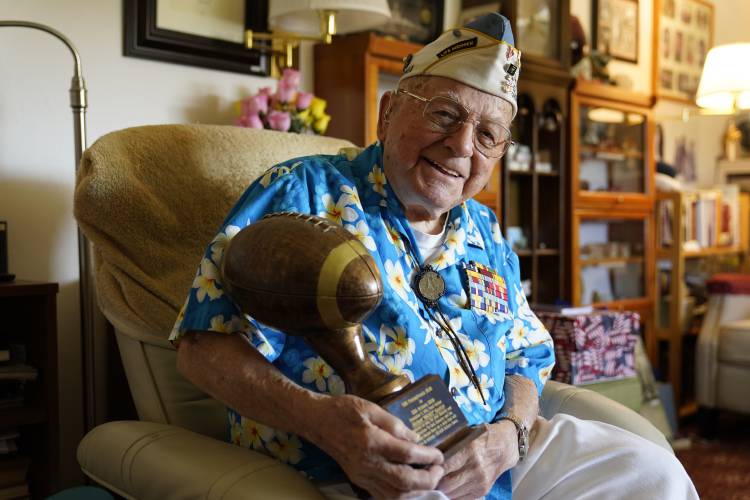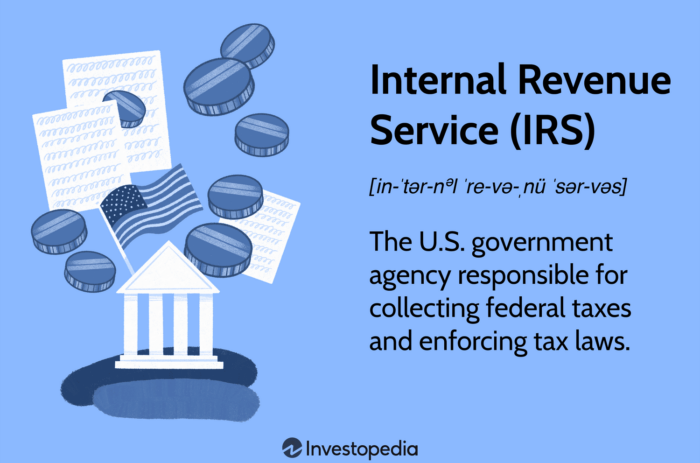
Mickey Ganitch, a 101-year-old survivor of the attack on Pearl Harbor, holds a football statue he was given, in the living room of his home in San Leandro, Calif., Nov. 20, 2020. Ganitch was getting ready for a match pitting his ship, the USS Pennsylvania, against the USS Arizona when Japanese planes bombed Pearl Harbor on Dec. 7, 1941.
redo Jump to...
print Print...
(from Local CBS4 Indianapolis) — Navy sailor Mickey Ganitch was getting ready to play in a Pearl Harbor football game as the day dawned on Dec. 7, 1941. The pigskin showdown never happened. Instead, Mr. Ganitch spent the morning, still wearing his football padding and brown team shirt, scanning the sky for threats as Japanese planes rained bombs on the U.S. Pacific Fleet.
Seventy-nine years later, the health risks of the coronavirus pandemic are preventing Mr. Ganitch and other Pearl Harbor survivors from attending an annual ceremony remembering those killed in the attack. The 101-year-old has attended most years since the mid-2000s, but will have to observe the moment from California this year.
The National Park Service and the Navy, who jointly host the annual event, have also closed the ceremony to the public to limit the size of the gathering. The event with will be livestreamed online instead.
Nearly eight decades ago, Ganitch’s USS Pennsylvania football team was scheduled to face off against the USS Arizona. As usual, they donned their uniforms on board their ship because there wasn’t anywhere to change clothes near the field.
As the aerial assault began at 7:55 a.m., Ganitch scrambled from the ship’s living compartment to his battle station about 70 feet above the main deck. His job was to serve as a lookout and report “anything that was suspicious.”
He saw a plane coming over the top of a nearby building. His ship’s gunners trained their guns on the aircraft and shot it down.
The Pennsylvania was in dry dock at the time, which protected it from the torpedoes that pummeled so many other vessels that day. It was one of the first to return fire on the attacking planes. Even so, the Pennsylvania lost 31 men. Ganitch said a 500-pound bomb missed him by just 45 feet.
He didn’t have time to think and did what he had to do.
“You realize that we’re in the war itself and that things had changed,” he said.
The USS Arizona suffered a much worse fate, losing 1,177 Marines and sailors as it quickly sank after being pierced by two bombs. More than 900 men remain entombed on the ship where it rests on the seafloor in the harbor. Altogether, more than 2,300 U.S. troops died in the attack.
It’s because of them that Mr. Ganitch feels obliged to return to Pearl Harbor for an annual remembrance ceremony on Dec. 7.
“We had a lot of people die that particular day. A lot of the people, a lot of them that I knew died that day. So I figure that by being there, we’re honoring them. They’re the heroes,” Mr. Ganitch said.
Ganitch served the remainder of the war on the Pennsylvania, participating in the U.S. recapture of Attu and Kiska in Alaska. The battleship bombarded Japanese positions to help with the amphibious assaults of Pacific islands like Kwajelin, Saipan and Guam.
Ganitch remained in the Navy for more than 20 years. Afterward, he briefly worked in a bowling alley before becoming the shop foreman at a fish net manufacturing plant.
Along the way, he had four children, 13 grandchildren, 18 great-grandchildren and 9 great-great grandchildren. He and his wife, who is now 90, have been married 57 years.
From Local CBS4 Indianapolis .com. Reprinted here for educational purposes only. May not be reproduced on other websites without permission from CBS4.
Questions
1. Who said the Japanese attack on Pearl Harbor is “a date which will live in infamy?”
2. Navy veteran Mickey Ganitch has attended the commemoration ceremony in Pearl Harbor multiple times. Why is he staying home this year?
3. For what reason has Mr. Ganitch returned to Pearl Harbor so many times?
4. a) Ask a grandparent what he/she learned about Pearl Harbor in school.
b) Ask a parent the same question. Compare their answers. Then contrast this with what you learned about the Japanese attack on Pearl Harbor.
5. Read the “Background” and check out the “Resources” below.
a) How much of this information did you know?
b) Why is it important for students to learn about Pearl Harbor?
Background
THE JAPANESE ATTACK ON PEARL HARBOR killed 2,403 U.S. personnel, including 68 civilians, and destroyed or damaged 19 U.S. Navy ships, including 8 battleships.
The attack on Pearl Harbor was a surprise military strike conducted by the Imperial Japanese Navy against the United States naval base at Pearl Harbor, Hawaii on the morning of December 7, 1941.
- The base was attacked by 353 Japanese aircraft in two waves, launched from six aircraft carriers.
- Four U.S. Navy battleships were sunk (two of which were raised and returned to service later in the war) and the four other battleships present were damaged*
- The Japanese also sank or damaged three cruisers, three destroyers, an anti-aircraft training ship and one minelayer.
- 188 U.S. aircraft were destroyed, 2,402 personnel were killed and 1,282 were wounded.
- The power station, shipyard, maintenance, and fuel and torpedo storage facilities, as well as the submarine piers and headquarters building (also home of the intelligence section) were not attacked.
- Japanese losses were light, with 29 aircraft and five midget submarines lost, and 65 servicemen killed or wounded. One Japanese sailor was captured.
- The following day (December 8) the United States declared war on Japan.
- Subsequent operations by the U.S., as well as the Axis alliance, prompted Germany and Italy to declare war on the U.S. on December 11, which was reciprocated by the U.S. the same day.
- Despite numerous historical precedents for unannounced military action, the lack of any formal warning by Japan, particularly while negotiations were still apparently ongoing, led to President Franklin D. Roosevelt proclaiming December 7, 1941, “a date which will live in infamy.” (exerpted from wikipedia)
*About the Battleships:
- USS Arizona (Kidd’s flagship): hit by four armor-piercing bombs, exploded; total loss. 1,177 dead.
- USS Oklahoma: hit by five torpedoes, capsized; total loss. 429 dead. Refloated November 1943; capsized and lost while under tow to the mainland May 1947.
- USS West Virginia: hit by two bombs, seven torpedoes, sunk; returned to service July 1944. 106 dead.
- USS California: hit by two bombs, two torpedoes, sunk; returned to service January 1944. 100 dead.
- USS Nevada: hit by six bombs, one torpedo, beached; returned to service October 1942. 60 dead.
- USS Tennessee: hit by two bombs; returned to service February 1942. 5 dead.
- USS Maryland: hit by two bombs; returned to service February 1942. 4 dead (including floatplane pilot shot down).
- USS Pennsylvania (Kimmel’s flagship): in drydock with Cassin and Downes, hit by one bomb, debris from USS Cassin; remained in service. 15 men killed (including her executive officer), 14 missing, and 38 wounded.
In a speech Dec. 8, 1941 asking Congress to declare war on Japan after the bombing of Pearl Harbor, President Franklin D. Rooselvelt said in part:
“Yesterday, December 7, 1941 – a date which will live in infamy – the United States of America was suddenly and deliberately attacked by naval and air forces of the Empire of Japan… No matter how long it may take us to overcome this premeditated invasion, the American people will through their righteous might win through to absolute victory… With confidence in our armed forces – with the unbounded determination of our people – we will gain the inevitable triumph – so help us God. I, therefore, ask that the Congress declare that since the dastardly and unprovoked attack by Japan on Sunday, December 7th, a state of war has existed between the United States and the Japanese Empire.”
-Read FDR’s speech to Congress at fdrlibrary.marist.edu, OR
-Listen to FDR’s speech to Congress at history.com.
Watch President Franklin D. Roosevelt’s speech to Congress on Dec. 8, 1941 the day after the Japanese bombing of Pearl Harbor, in which he asks Congress to declar war on Japan:
Resources
Watch a December 3, 2020 CBS4 news report:
The Japanese attacked Pearl Harbor to cripple the U.S. Pacific Fleet, but America’s aircraft carriers––perhaps the most vital type of warship––were not stationed there on December 7. Not long after the attack, these ships would go on the offensive against the Japanese. (Read about U.S. victories involving aircraft carriers:
See 2 editorials:
See previouse news articles:
- USS Arizona survivor gets hero’s welcome in return to Hawaii (Dec. 2019)
- Oldest U.S. survivor of Pearl Harbor dies at 106 (Dec. 2018)
- ‘Heroes all’: Survivors mark 76th anniversary of Pearl Harbor attack (Dec. 2017)
- Oldest Pearl Harbor Survivor, 104, Flies Back to Honolulu (Dec. 2016)
Watch a Pearl Harbor video below:
Daily “Answers” emails are provided for Daily News Articles, Tuesday’s World Events and Friday’s News Quiz.



